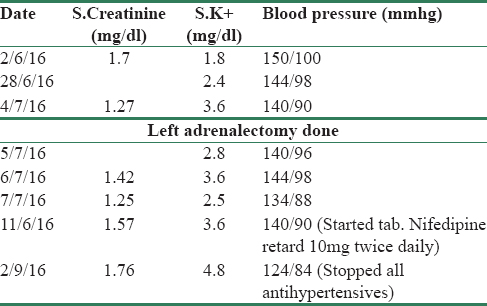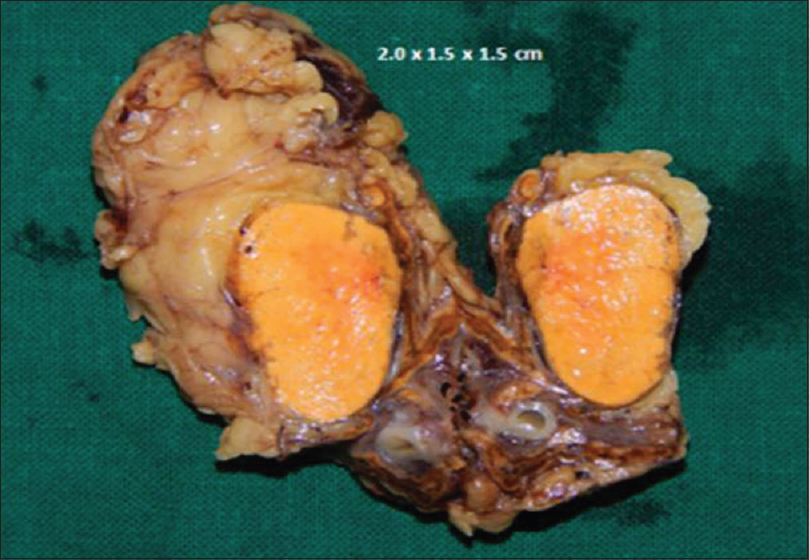Translate this page into:
Autosomal Dominant Polycystic Kidney Disease and Hypertension Masquerading Primary Aldosteronism
Address for correspondence: Dr. P. D. Mital, A-5 Vrundavan Park Society, VIP Road, Karelibaug, Vadodara - 390 018, Gujarat, India. E-mail: mital.parikh@ymail.com
This is an open access journal, and articles are distributed under the terms of the Creative Commons Attribution-NonCommercial-ShareAlike 4.0 License, which allows others to remix, tweak, and build upon the work non-commercially, as long as appropriate credit is given and the new creations are licensed under the identical terms.
This article was originally published by Medknow Publications & Media Pvt Ltd and was migrated to Scientific Scholar after the change of Publisher.
Abstract
Hypertension is a frequent early manifestation of autosomal dominant polycystic kidney disease (ADPKD). Many mechanisms cause hypertension in ADPKD; however, primary aldosteronism (PA) as a possible manifestation of hypertension in ADPKD is extremely rare. The diagnosis of PA in ADPKD is extremely challenging because multiple renal cysts can mask the identification of adrenal adenomas, and ADPKD is associated with hypertension in majority of cases. Here, we report a unique case of a young lady with ADPKD with hypertension masquerading PA.
Keywords
Autosomal dominant polycystic kidney disease
hypertension
primary aldosteronism
Introduction
Hypertension presents as a usual clinical symptom in 50%–75% of autosomal dominant polycystic kidney disease (ADPKD) patients.[1] Primary aldosteronism (PA) occurs in approximately 10% of patients with mild to moderate hypertension and 20% of patients with resistant hypertension.[2] The occurrence of PA in ADPKD patients is extremely rare. Here, we describe a unique case of ADPKD with adrenal mass.
Case Report
A 33-year-old female, during routine visit to obstetrician at the time of her first pregnancy (in 2008), detected to have hypertension and on routine ultrasonography found to have multiple cysts in both the kidneys. Her mother and maternal uncle also had polycystic kidney disease. She was started on antihypertensive medications; however, there were no signs of preeclampsia and her blood pressure (BP) was well controlled. However, she lost her baby due to intrauterine fetal death at 5 months of gestation.
Since then, she was on regular follow-up for her hypertension and on regular treatment with nifedipine 10 mg twice a day, her BP remaining around 130–140/80–90 mmHg. Her two-dimensional echo revealed concentric left ventricular hypertrophy. Her renal function at that time was normal (serum creatinine was 0.61 mg%).
In October 2013, she had complaints of weakness, body ache with cramps and leg pain with feeling of easy fatigability; however, this was attributed to nutritional deficiency and treated with multivitamins. Her BP at that time was 140/80 mmHg. In 2016, during her workup for surrogacy, she was advised to consult nephrologist, so she came to Muljibhai Patel Urological Hospital, Nadiad.
On investigation, her serum potassium was found to be 1.8–2 mg/dl and serum creatinine of 1.7 mg%. In view of hypertension and hypokalemia ( first time detected), she was advised computed tomography (CT) abdomen to rule out adrenal lesion.
Her CT abdomen showed left adrenal cyst/adenoma of 2.3 cm × 2 cm [Figure 1]. She was advised to undergo further investigations and removal of mass. She underwent magnetic resonance imaging of abdomen which showed left adrenal nodule of 2.7 × 2.5 cm in size. Her serum potassium was 2.4, she was supplemented with potassium, and spironolactone was started. Her BP was 120/80 mmHg (on nifedipine 20 mg and aldactone).

- Computed tomography scan showing adrenal adenoma
On further investigation of the adrenal mass, her serum aldosterone was high - 69.8 ng/dl and plasma renin activity (PRA) was low - 0.68 ng/ml/h, aldosterone/PRA ratio being 102.6, thus favoring primary hyperaldosteronism. She underwent left adrenalectomy on July 5, 2016 [Table 1]. Intraoperative course was uneventful with her BP remaining around 140–150 mmHg systolic without antihypertensive medications. Her serum creatinine remained around 1.2–1.3 mg/dl with serum potassium of 2.5–2.7 mg/dl postsurgery [Table 1].

On postadrenalectomy (gross specimen) [Figure 2], she needed antihypertensive medications for a month, gradually her BP reached normal range (120/80 mmHg) and her antihypertensives were stopped with well-controlled BP. Her serum potassium levels also reached normal range (3.5–5 mg%) without any supplementation.

- Gross specimen of adenoma removed
Discussion
Approximately 60% of ADPKD patients present with hypertension before renal function become impaired.[3] Mostly clinicians consider the intrarenal activation of the renin–angiotensin–aldosterone system (RAAS) to be the main pathogenesis of hypertension in ADPKD patients, though there may be additional causes of hypertension. Identifying ADPKD-affected individuals with modifiable secondary hypertension, such as aldosteronism, is challenging since multiple renal cysts may obscure the identification of adrenal adenomas. Avoiding delays in diagnosis will permit aggressive BP treatment, early inhibition of the RAAS, and decreased cardiovascular risks.[45]
Once the coexistence of hypokalemia and resistant hypertension is identified in ADPKD patients, a secondary cause of hypertension should be suspected. Screening for PA can benefit both the patient and clinician, particularly in cases where hypertension is severe and/or resistant to treatment; in this situation, the removal of APAs can allow effective controlling of BP.
In addition to aldosterone-induced target organ inflammation and fibrosis, aldosterone has been linked to components of metabolic syndrome, including hypertension, insulin resistance, and dyslipidemia.[6789] The detrimental effects of aldosterone may expose patients to a greater risk of cardiovascular diseases, but the long-term effects of aldosterone on ADPKD patients are currently unknown. Liou et al. also showed similar case report of association of aldosterone-producing adrenal adenoma in a patient with ADPKD in 1994.[10]
Until now, the mechanisms of aldosterone-induced renal cyst formation have not been elucidated. Hypokalemia has been shown to increase cyst formation in rat models;[11] furthermore, as Torres et al.[12] described, chronic hypokalemia in humans is accompanied by enhanced renal cytogenesis and may lead to interstitial scarring and renal insufficiency. Renal cysts also have been reported to develop in potassium-depleted human subjects in whom primary or secondary hyperaldosteronism was present. Although these studies do not prove causality, these interactions of PA and ADPKD warrant further investigation. After the treatment of PA, monitoring the change in cyst size/number may help explain the interaction between PA and ADPKD. In addition, further studies are necessary to determine if the progression of ADPKD is modified or reversed by the treatment of PA.
Financial support and sponsorship
Nil.
Conflicts of interest
There are no conflicts of interest.
References
- The renin-angiotensin-aldosterone system and autosomal dominant polycystic kidney disease. N Engl J Med. 1990;323:1091-6.
- [Google Scholar]
- Association of hypokalemia, aldosteronism, and renal cysts. N Engl J Med. 1990;322:345-51.
- [Google Scholar]
- Hypertension in autosomal-dominant polycystic kidney disease: Early occurrence and unique aspects. J Am Soc Nephrol. 2001;12:194-200.
- [Google Scholar]
- Evidence for an increased rate of cardiovascular events in patients with primary aldosteronism. J Am Coll Cardiol. 2005;45:1243-8.
- [Google Scholar]
- The association of serum potassium level with left ventricular mass in patients with primary aldosteronism. Eur J Clin Invest. 2011;41:743-50.
- [Google Scholar]
- Insulin resistance and hyperinsulinemia are related to plasma aldosterone levels in hypertensive patients. Diabetes Care. 2007;30:2349-54.
- [Google Scholar]
- A possible association between primary aldosteronism and a lower beta-cell function. J Hypertens. 2007;25:2125-30.
- [Google Scholar]
- Plasma aldosterone is independently associated with the metabolic syndrome. Hypertension. 2006;48:239-45.
- [Google Scholar]
- Prevalence and characteristics of the metabolic syndrome in primary aldosteronism. J Clin Endocrinol Metab. 2006;91:454-9.
- [Google Scholar]
- The association of aldosterone-producing adrenal adenoma in a patient with autosomal dominant polycystic kidney disease. Am J Kidney Dis. 1994;23:739-42.
- [Google Scholar]
- Autosomal dominant polycystic kidney disease: Emerging concepts of pathogenesis and new treatments. Cleve Clin J Med. 2009;76:97-104.
- [Google Scholar]
- Association of hypokalemia, aldosteronism, and renal cysts. N Engl J Med. 1990;322:345-51.
- [Google Scholar]







